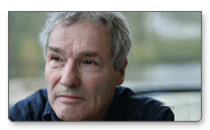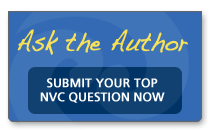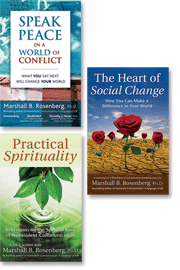Ask the Author, continued
If someone opposes a cause I identify with, it’s easy for my heart to contract and for my mind to view them as an enemy.
When this happens, I may want to pause and fully recognize and accept the fact that I am harboring "enemy images." I can do so by welcoming and opening myself to this present-moment experience:
- What does it feel like to be in this body right now as I harbor enemy images of that person? (What kind of physical sensations do I notice in my neck, chest, face, etc.?)
- What is my mind doing with this awareness? (Am I judging myself for not being adequately "compassionate," "evolved," "NVC"? Or perhaps I’m defending my enemy images: "Hey, EVERYONE agrees the guy is a hate-mongering bigot!")
Before I move forward to “transform” these enemy images, I may want to ask myself WHY –- I mean, why bother? Sometimes the answer may come quick and clear:
- “Obviously I am in pain. This state of separation, alienation, hating and aversion simply hurts!”
- “I trust and value the NVC paradigm that calls forth heart connection as the basis from which to resolve differences. I am committed to living that paradigm.”
- “I am remembering how much more power I have in effecting change when I replace enemy images with the consciousness of mutual needs.”
If no answer pops up for me, I may choose to continue holding enemy images. However, I will be watching carefully for what happens in my world - both internally and externally - when I do this.
On the other hand, if I choose to transform and release my enemy, I’d first list all my judgments and complaints about them on a piece of paper. One by one, I would ask myself to touch and explore the unmet need hidden beneath each label, blame, expletive, analysis, etc.
Having taken time to appreciate all these needs, I could turn my attention to the cause I’m championing - imagining a world in which that cause is fully realized. How would the world look? How would it be different from today? How would I feel living in such a world? What needs of mine would be richly fulfilled in that world?
After I have grounded and connected to the beautiful needs that this cause enlivens in me, I may be ready (or not) to peer out in curiosity at that fellow human who is opposing the cause. What’s going on for them? What are they seeing? Hearing? Feeling? What values are they yearning to realize or protect?
I remind myself that this other being and I – we share the same needs and values, but our strategies for realizing them are different. What comes up for them when they encounter my strategies (i.e. my “cause” and the way I am going about it)? What needs may not be met for them?
I aspire to stay connected to my own needs, to recognize my opponent as an integral part of the humanity that stirs in me, and to empathize with their reality - their suffering and dreams, feelings and needs. If I can do this (rather than allow my energy to get caught up in thoughts and images of what’s wrong with them), I will have greatly increased the likelihood of being able to affect them and the situation I care about.
Lucy Leu is the co-founder of Freedom Project, author of the NVC Companion Workbook, co-author of the NVC Toolkit for Facilitators. She lives in Victoria, B.C.




